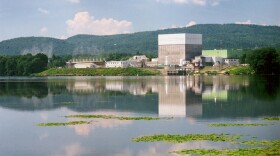Deconstruction of a nuclear plant in Vernon, Vermont, that closed more than a decade ago is nearing completion. An update was provided at the latest Vermont Nuclear Decommissioning Citizens Advisory Panel meeting.
NorthStar is a national company that decommissions former nuclear plants across the country. It began deconstructing Vermont Yankee’s buildings and removing nuclear materials in 2019.
Corey Daniels, NorthStar Senior Project Manager, said they are nearing the last phase of physical decommissioning.
“We remain well on track to complete ahead of the 2030 commitment for the MOU and most of the physical work, it will be coming to a close at the end of this year.”
Daniels provided photos of the ongoing deconstruction of the reactor building.
“What you're looking at is the top of the last large structure, the reactor building, and that is with the top 38 feet or so removed. And directly in front of the excavator in the center is the cavity where the reactor sits down into. And to the left of it, kind of between the two excavators, is the spent fuel pool itself. Everything is completely decontaminated.” Daniels added, “We're basically deconstructing this building in reverse order of the way it was constructed.”
Former New England Coalition member Clay Turnbull was among the anti-nuclear activists who wanted to see the Vermont Yankee plant shut down -- an effort that became less fervent once NorthStar took ownership with plans to decommission the site.
“It’s wonderful that the physical facilities have been removed as quickly, and appears thoroughly, as they have been. But of concern is I have not heard what the projected radiological contamination of the site will be after the removal of the last building that they’re working on.”
Beyond any residual radiation at the site, panel members have also been trying to figure out where to send the spent nuclear waste for permanent storage. Fifty-eight casks remain on site, and there is no federal repository to take the material. Lissa Weinmann, chair of the Waste Policy Committee, told the full advisory panel that she recently attended workshops that discussed the potential for localities to host spent nuclear fuel.
“DOE (Department of Energy) and this administration seems to be abandoning the long held global approach toward consent. They are changing it to collaboration-based siting, which would essentially mean that states and tribes would not be able to veto any federal siting decision,” Weinmann said. “While they're changing their language, they say that they don't want to site anything without the actual willingness of the community.”
NorthStar conducts required environmental monitoring to assure that any non-radiological materials are found and managed. One groundwater site has been found to be contaminated with PFAS. Patricia Coppolino, the Vermont Department of Environmental Conservation’s Environmental Program Manager, said they are investigating how widespread the contamination is.
“We believe based on the chemical signature the PFAS is from a former transformer fire. The environmental consultant working on behalf of NorthStar is preparing a work plan for us to look at the degree and extent of that contamination. So we're still looking to see how much of it there is and where it has spread to. Once we have all of that information, then we can move on to what we call a corrective action plan.”
Panel member David Eastman felt there should be a deeper look into potential PFAS contamination at the Vermont Yankee site.
“I just think that that this is a significant issue going forward for the site. The public has a right to really understand as much as possible what's there.”
Coppolino noted there are no private drinking wells in the area, and what has been detected is only slightly above Vermont’s regulations.
“It doesn't appear to be migrating anywhere that it's going to cause a problem. The largest impact, if there is an impact, would be the Connecticut River and by the time it actually gets to the Connecticut River it's probably not going to be detectable.”
The discussion on nuclear waste storage and the final deconstruction of Vermont Yankee comes at a time when there is renewed interest in nuclear power as a green energy source. In New York, Governor Kathy Hochul announced in June a directive to build the state’s first new nuclear power facility in a generation.
Turnbull says there are other options.
“We really must learn from our past mistakes. It’s very sad to me to see it even being considered. Solutions are in front of us in the form of efficiency, solar panels and wind turbines and not from splitting atoms. We’re still dealing with the waste. The waste was always the Achilles’ Heel. But it would be very sad to see the resources go into that.”
The Vermont Yankee Nuclear Power Plant began operating in 1972 and shut down on December 29, 2014.













